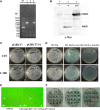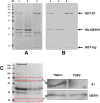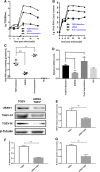UBXN1 interacts with the S1 protein of transmissible gastroenteritis coronavirus and plays a role in viral replication
- PMID: 31029162
- PMCID: PMC6487014
- DOI: 10.1186/s13567-019-0648-9
UBXN1 interacts with the S1 protein of transmissible gastroenteritis coronavirus and plays a role in viral replication
Abstract
Transmissible gastroenteritis coronavirus (TGEV) is an enteropathogenic coronavirus that causes diarrhea in pigs and is associated with high morbidity and mortality in sucking piglets. S1 is one of two protein domains in the spike (S) glycoprotein and is responsible for enteric tropism, sialic acid recognition, and host receptor binding. Although there has been extensive research on the S1 protein of TGEV, little is known about the intracellular role of TGEV-S1. In the present study, we used yeast two-hybrid screening of a cDNA library from porcine intestinal cells to identify proteins that interact with TGEV-S1. Among 120 positive clones from the library, 12 intracellular proteins were identified after sequencing and a BLAST search. These intracellular proteins are involved in protein synthesis and degradation, biological signal transduction, and negative control of signaling pathways. Using a glutathione-S-transferase (GST) pulldown assay and Co-IP, we found that UBXN1 interacts with the S1 protein. Here, we observed that TGEV infection led to increased UBXN1 expression levels during the late phase of infection in IPEC-J2 cells. Inhibition of UBXN1 in IPEC-J2 cells via siRNA interference significantly decreased the viral titer and downregulated the expression of S1. UBXN1 overexpression significantly increased the viral copy number. Additionally, we provided data suggesting that UBXN1 negatively regulates IFN-β expression after TGEV infection. Finally, our research indicated that UBXN1 plays a vital role in the process of TGEV infection, making it a candidate target for the development of a novel antiviral method.
Figures






Similar articles
-
EIF4A2 interacts with the membrane protein of transmissible gastroenteritis coronavirus and plays a role in virus replication.Res Vet Sci. 2019 Apr;123:39-46. doi: 10.1016/j.rvsc.2018.12.005. Epub 2018 Dec 17. Res Vet Sci. 2019. PMID: 30583231 Free PMC article.
-
The PERK Arm of the Unfolded Protein Response Negatively Regulates Transmissible Gastroenteritis Virus Replication by Suppressing Protein Translation and Promoting Type I Interferon Production.J Virol. 2018 Jul 17;92(15):e00431-18. doi: 10.1128/JVI.00431-18. Print 2018 Aug 1. J Virol. 2018. PMID: 29769338 Free PMC article.
-
Porcine transmissible gastroenteritis virus inhibits NF-κB activity via nonstructural protein 3 to evade host immune system.Virol J. 2019 Aug 5;16(1):97. doi: 10.1186/s12985-019-1206-9. Virol J. 2019. PMID: 31382996 Free PMC article.
-
Transferrin receptor 1 is a supplementary receptor that assists transmissible gastroenteritis virus entry into porcine intestinal epithelium.Cell Commun Signal. 2018 Oct 20;16(1):69. doi: 10.1186/s12964-018-0283-5. Cell Commun Signal. 2018. PMID: 30342530 Free PMC article.
-
Looking for a needle in a haystack: Cellular proteins that may interact with the tyrosine-based sorting signal of the TGEV S protein.Virus Res. 2015 Apr 16;202:3-11. doi: 10.1016/j.virusres.2014.11.029. Epub 2014 Dec 4. Virus Res. 2015. PMID: 25481285 Free PMC article. Review.
Cited by
-
Proteomic and phosphorylated proteomic landscape of injured lung in juvenile septic rats with therapeutic application of umbilical cord mesenchymal stem cells.Front Immunol. 2022 Oct 21;13:1034821. doi: 10.3389/fimmu.2022.1034821. eCollection 2022. Front Immunol. 2022. PMID: 36341346 Free PMC article.
-
The Roles of Apoptosis in Swine Response to Viral Infection and Pathogenesis of Swine Enteropathogenic Coronaviruses.Front Vet Sci. 2020 Nov 26;7:572425. doi: 10.3389/fvets.2020.572425. eCollection 2020. Front Vet Sci. 2020. PMID: 33324698 Free PMC article. Review.
-
HSP90AB1 Is a Host Factor Required for Transmissible Gastroenteritis Virus Infection.Int J Mol Sci. 2023 Nov 4;24(21):15971. doi: 10.3390/ijms242115971. Int J Mol Sci. 2023. PMID: 37958953 Free PMC article.
-
Seroprevalence of the novel swine acute diarrhea syndrome coronavirus in China assessed by enzyme-linked immunosorbent assay.Front Cell Infect Microbiol. 2024 Apr 26;14:1367975. doi: 10.3389/fcimb.2024.1367975. eCollection 2024. Front Cell Infect Microbiol. 2024. PMID: 38736750 Free PMC article.
References
-
- Ahn DJ, Youm JW, Kim SW, Yoon WK, Kim HC, Hur TY, Joung YH, Jeon JH, Kim HS. Expression of the S glycoprotein of transmissible gastroenteritis virus (TGEV) in transgenic potato and its immunogenicity in mice. Korean J Vet Res. 2013;53:217–224. doi: 10.14405/kjvr.2013.53.4.217. - DOI
MeSH terms
Substances
Grants and funding
LinkOut - more resources
Full Text Sources
Research Materials

